Magnetically Modified Biosorbent for Rapid Beryllium Elimination from the Aqueous Environment
Abstract
:1. Introduction
2. Materials and Methods
2.1. Materials
2.2. Preparation of Magnetic Sorbents
2.3. Methods
2.4. Characterisation of Magnetic Sorbents
2.5. Potentiometric Titration
2.6. Sorption Experiments
2.7. Sorbents Regeneration
3. Results and Discussion
3.1. Characterisation of WB, MWBI, and MWBII
3.1.1. SEM-EDX Analysis
3.1.2. IR Spectroscopy
3.2. Potentiometric Titration
3.3. Kinetic Test and the Effect of pH
3.3.1. Effect of pH
3.3.2. Kinetic Parameters
3.4. Sorption Test
3.5. Desorption Test
4. Conclusions
Supplementary Materials
Author Contributions
Funding
Institutional Review Board Statement
Informed Consent Statement
Data Availability Statement
Acknowledgments
Conflicts of Interest
References
- Martín-González, A.; Díaz, S.; Borniquel, S.; Gallego, A.; Gutiérrez, J.C. Cytotoxicity and bioaccumulation of heavy metals by ciliated protozoa isolated from urban wastewater treatment plants. Res. Microbiol. 2006, 157, 108–118. [Google Scholar] [CrossRef] [PubMed]
- Raskin, I.; Kumar, P.B.A.N.; Dushenkov, S.; Salt, D.E. Bioconcentration of heavy metals by plants. Curr. Opin. Biotechnol. 1994, 5, 285–290. [Google Scholar] [CrossRef]
- Åström, M.E.; Yu, C.; Peltola, P.; Reynolds, J.K.; Österholm, P.; Nystrand, M.I.; Augustsson, A.; Virtasalo, J.J.; Nordmyr, L.; Ojala, A.E.K. Sources, transport and sinks of beryllium in a coastal landscape affected by acidic soils. Geochim. Cosmochim. Acta 2018, 232, 288–302. [Google Scholar] [CrossRef]
- World Health Organization. Beryllium in Drinking-Water: Background Document for Development of WHO Guidelines for Drinking-Water Quality; World Health Organization: Geneva, Switzerland, 2009; Available online: https://apps.who.int/iris/handle/10665/70172 (accessed on 24 June 2021).
- Armiento, G.; Bellatreccia, F.; Cremisini, C.; Della Ventura, G.; Nardi, E.; Pacific, R. Beryllium natural background concentration and mobility a reappraisal examining the case of high Be-bearing pyroclastic rocks. Environ. Monit. Assess. 2013, 185, 559–572. [Google Scholar] [CrossRef] [PubMed]
- Willis, H.H.; Florig, H.K. Potential exposures and risks from beryllium-containing products. Risk. Anal. 2002, 22, 1019–1033. [Google Scholar] [CrossRef]
- Boffetta, P.; Fryzek, J.P.; Mandel, J.S. Occupational exposure to beryllium and cancer risk: A review of the epidemiologic evidence. Crit. Rev. Toxicol. 2012, 42, 107–118. [Google Scholar] [CrossRef] [PubMed] [Green Version]
- Marchand-Adam, S.; Valeyre, D. Chronic pulmonary berylliosis: A model of interaction between environment and genetic predisposition (part 1). Mineralogy, toxicology, epidemiology and risk factors. Rev. Des Mal. Respir. 2005, 22, 257–269. [Google Scholar] [CrossRef]
- Tanveer, M.; Wang, L. Potential targets to reduce beryllium toxicity in plants: A review. Plant Physiol. Biochem. 2019, 139, 691–696. [Google Scholar] [CrossRef] [PubMed]
- Shah, A.; Tanveer, M.; Hussain, S.; Guozheng, Y. Beryllium in the environment: Whether fatal for plant growth? Rev. Environ. Sci. Biotechnol. 2016, 15, 549–561. [Google Scholar] [CrossRef]
- Navrátil, T.; Skřivan, P.; Minařík, L.; Žlgová, A. Beryllium geochemistry in the lesni potok catchment (Czech Republic), 7 years of systematic study. Aquat. Geochem. 2012, 8, 121–133. [Google Scholar] [CrossRef]
- Veselý, J.; Beneš, P.; Ševčí, K. Occurrence and speciation of beryllium in acidified freshwaters. Water Res. 1989, 23, 711–717. [Google Scholar] [CrossRef]
- Jagoe, C.H.; Matey, V.E.; Haines, T.A.; Komov, V.T. Effect of beryllium on fish in acid water is analogous to aluminum toxicity. Aquat. Toxicol. 1993, 24, 241–256. [Google Scholar] [CrossRef]
- El-Soad, A.M.A.; El-Magied, M.O.A.; Atrees, M.S.; Kovaleva, E.G.; Lazzara, G. Synthesis and characterization of modified sulfonated chitosan for beryllium recovery. Int. J. Biol. Macrom. 2019, 139, 153–160. [Google Scholar] [CrossRef] [PubMed]
- Basargin, N.N.; Miroshnichenko, O.V. Beryllium(II) sorption from aqueous solutions by polystyrene-based chelating polymer sorbents. Russ. J. Inorg. Chem. 2012, 57, 758–762. [Google Scholar] [CrossRef]
- Othman, S.H.; Shabaan, M.; Demerdash, M.; Saleh, M.M. Experimental and theoretical investigation of sorption kinetics of beryllium on Amberlite-IR-120 sorbent. J. Nucl. Mater. 2009, 392, 427–433. [Google Scholar] [CrossRef]
- Ramesh, A.; Kurakalva, R.M.; Seshaiah, K.; Nettem, V.C. Removal of beryllium from aqueous solutions by zeolite 4A and bentonite. Sep. Sci. Technol. 2007, 37, 1123–1134. [Google Scholar] [CrossRef]
- Cao, D.-Q.; Song, X.; Fang, X.-M.; Yang, W.-Y.; Hao, X.-D.; Iritani, E.; Katagiri, N. Membrane filtration-based recovery of extracellular polymer substances from excess sludge and analysis of their heavy metal ion adsorption properties. Chem. Eng. J. 2018, 354, 866–874. [Google Scholar] [CrossRef]
- Silva, J.E.; Paiva, A.P.; Soares, D.; Labrincha, A.; Castro, F. Solvent extraction applied to the recovery of heavy metals from galvanic sludge. J. Hazard. Mater. 2005, 120, 113–118. [Google Scholar] [CrossRef] [PubMed] [Green Version]
- Chen, Q.; Yao, Y.; Li, X.; Lu, J.; Zhou, J.; Huang, Z. Comparison of heavy metal removals from aqueous solutions by chemical precipitation and characteristics of precipitates. J. Water Process Eng. 2018, 26, 289–300. [Google Scholar] [CrossRef]
- Nemati, M.; Hosseini, S.M.; Shabanian, M. Novel electrodialysis cation exchange membrane prepared by 2-acrylamido-2-methylpropane sulfonic acid; heavy metal ions removal. J. Hazard. Mater. 2017, 3375, 90–104. [Google Scholar] [CrossRef]
- Islam, M.D.A.; Morton, D.W.; Johnson, B.B.; Pramanik, B.K.; Mainali, B.; Angove, M.J. Metal ion and contaminant sorption onto aluminium oxide-based materials: A review and future research. J. Environ. Chem. Eng. 2018, 6, 6853–6869. [Google Scholar] [CrossRef]
- Mirza, A.; Ahmad, R. Novel recyclable (Xanthan gum/montmorillonite) bionanocomposite for the removal of Pb (II) from synthetic and industrial wastewater. Environ. Technol. Innov. 2018, 11, 241–252. [Google Scholar] [CrossRef]
- Akpomie, K.D.; Dawodu, F.A.; Adebowale, K.O. Mechanism on the sorption of heavy metals from binary-solution by a low cost montmorillonite and its desorption potential. Alex. Eng. J. 2015, 54, 757–767. [Google Scholar] [CrossRef] [Green Version]
- Tokarčíková, M.; Seidlerová, J.; Motyka, O.; Životský, O.; Drobíková, K.; Mamulová Kutláková, K. Easy and low-cost preparation method of magnetic montmorillonite/FexOy composite: Initial study for future applications. Monatsh. Chem. 2020, 151, 1–10. [Google Scholar] [CrossRef]
- Mahdavinasa, M.; Hamzehloueian, M.; Sarrafi, Y. Preparation and application of magnetic chitosan/graphene oxide composite supported copper as a recyclable heterogeneous nanocatalyst in the synthesis of triazoles. Int. J. Biol. Macromol. 2019, 138, 764–772. [Google Scholar] [CrossRef] [PubMed]
- Peng, S.; Wang, S.; Hao, G.; Zhu, C.H.; Zhang, Y.; Lv, X.; Hu, Y.; Jiang, W. Preparation of magnetic flower-like carbon-matrix composites with efficient electromagnetic wave absorption properties by carbonization of MIL-101(Fe). J. Magn. Magn. Mater. 2019, 487, 165306. [Google Scholar] [CrossRef]
- Lu, F.; Dong, A.; Ding, G.; Xu, K.; Li, J.; You, L. Magnetic porous polymer composite for high performance adsorption of acid red 18 based on melamine resin and chitosan. J. Mol. Liq. 2019, 294, 111515. [Google Scholar] [CrossRef]
- Li, M.; Liu, H.; Chen, T.; Chen, D.; Wang, C.; Wei, L.; Wang, L. Efficient U(VI) adsorption on iron/carbon composites derived from the coupling of cellulose with iron oxides: Performance and mechanism. Sci. Total Environ. 2020, 703, 135604. [Google Scholar] [CrossRef]
- Rozumová, L.; Životský, O.; Seidlerová, J.; Motyka, O.; Šafařík, I.; Šafaříková, M. Magnetically modified peanut husks as an effective sorbent of heavy metals. J. Environ. Chem. Eng. 2016, 4, 549–555. [Google Scholar] [CrossRef]
- Montanarella, L.; Lugato, E. The application of biochar in the EU: Challenges and opportunities. Agronomy 2013, 3, 462–473. [Google Scholar] [CrossRef] [Green Version]
- Razzaghi, F.; Obour, P.B.; Arthur, F. Does biochar improve soil water retention? A systematic review and meta-analysis. Geoderma 2020, 361, 114055. [Google Scholar] [CrossRef]
- Werdin, J.; Fletcher, T.D.; Rayner, J.P.; Williams, N.S.G.; Farrell, C. Biochar made from low density wood has greater plant available water than biochar made from high density wood. Sci. Total Environ. 2020, 705, 135856. [Google Scholar] [CrossRef] [PubMed]
- Melia, P.M.; Busquets, R.; Hooda, P.S.; Cundy, A.B.; Sohi, S.P. Driving forces and barriers in the removal of phosphorus from water using crop residue, wood and sewage sludge derived biochars. Sci. Total Environ. 2019, 675, 623–631. [Google Scholar] [CrossRef] [PubMed] [Green Version]
- Mukherjee, A.; Zimmerman, A.R. Organic carbon and nutrient release from a range of laboratory-produced biochars and biochar–soil mixtures. Geoderma 2013, 193, 122–130. [Google Scholar] [CrossRef]
- Tan, X.; Liu, Y.; Zeng, G.; Wang, X.; Hu, X.; Gu, Y.; Yang, Z. Application of biochar for the removal of pollutants from aqueous solutions. Chemosphere 2015, 125, 70–85. [Google Scholar] [CrossRef]
- Hu, X.; Xu, J.; Wu, M.; Xing, J.; Bi, W.; Wang, K.; Ma, J.; Liu, X. Effects of biomass pre-pyrolysis and pyrolysis temperature on magnetic biochar properties. J. Anal. Appl. Pyrolysis. 2017, 127, 196–202. [Google Scholar] [CrossRef]
- Wang, S.; Tang, Y.; Li, K.; Mo, Y.; Li, H.; Gu, Z. Combined performance of biochar sorption and magnetic separation processes for treatment of chromium-contained electroplating wastewater. Bioresour. Technol. 2014, 174, 67–73. [Google Scholar] [CrossRef]
- Liang, S.; Shi, S.; Zhang, H.; Qiu, J.; Yu, W.; Li, M.; Gan, Q.; Yu, W.; Xiao, K.; Liu, B.; et al. One-pot solvothermal synthesis of magnetic biochar from waste biomass: Formation mechanism and efficient adsorption of Cr(VI) in an aqueous solution. Sci. Total Environ. 2019, 695, 133886. [Google Scholar] [CrossRef]
- Zhang, X.; Lv, L.; Qin, Y.; Xu, M.; Jia, X.; Chen, Z. Removal of aqueous Cr(VI) by a magnetic biochar derived from Melia azedarach wood. Bioresour. Technol. 2018, 256, 1–10. [Google Scholar] [CrossRef]
- Safarik, I.; Safarikova, M. One-step magnetic modification of non-magnetic solid materials. Internat. J. Mater. Res. 2014, 105, 104–107. [Google Scholar] [CrossRef]
- Trakal, L.; Veselská, V.; Šafařík, I.; Vítková, M.; Číhalová, S.; Komárek, M. Lead and cadmium sorption mechanisms on magnetically modified biochars. Bioresour. Technol. 2016, 203, 318–324. [Google Scholar] [CrossRef]
- Czech Standard CSN 72 2041, Part 11; TECHNOR Print, s.r.o.: Hradec Králové, Czech Republic, 1977.
- Tokarčíková, M.; Tokarský, J.; Mamulová Kutláková, K.; Seidlerová, J. Testing the stability of magnetic iron oxides/kaolinite nanocomposite under various pH conditions. J. Solid State Chem. 2017, 253, 329–335. [Google Scholar] [CrossRef]
- Schiewer, S.; Balaria, A. Biosorption of Pb2+ by original and protonated citrus peels: Equilibrium, kinetics, and mechanism. Chem. Eng. J. 2009, 146, 211–219. [Google Scholar] [CrossRef]
- Lagergren, S. Zur theorie der sogenannten adsorption geloster stoffe, Kungliga Svenska Vetenskapsakademiens. Handlingar 1898, 24, 1–39. [Google Scholar]
- Ho, Y.S.; McKay, G. Sorption of dye from aqueous solution by peat. Chem. Eng. J. 1998, 70, 115–124. [Google Scholar] [CrossRef]
- Weber, W.J.; Morris, J.C. Kinetics of adsorption carbon from solutions. J. Sanit. Eng. Div. 1963, 89, 31–60. [Google Scholar] [CrossRef]
- Wu, F.-C.; Tseng, R.-L.; Juang, R.-S. Initial behavior of intraparticle diffusion model used in the description of adsorption kinetics. Chem. Eng. J. 2009, 153, 1–8. [Google Scholar] [CrossRef]
- Freundlich, H.M. Over the Adsorption in Solution. J. Phys. Chem. A 1906, 57, 385–470. [Google Scholar]
- Taha, M.H. Sorption of U(VI), Mn (II), Cu(II), Zn(II), and Cd(II) from multi-component phosphoric acid solutions using MARATHON C resin. Environ. Sci. Pollut. Res. 2021, 28, 12475–12489. [Google Scholar] [CrossRef]
- Langmuir, I. The adsorption of gases on plane surfaces of glass, mica and platinum. J. Am. Chem. Soc. 1918, 40, 1361–1403. [Google Scholar] [CrossRef] [Green Version]
- McKay, G.; Blair, H.S.; Gardner, I.R. Adsorption of dyes on chitin. I. Equilibrium studies. J. Appl. Polym. Sci. 1982, 27, 3043–3057. [Google Scholar] [CrossRef]
- Eren, Z.; Acar, F.N. Adsorption of Reactive Black 5 from an aqueous solution: Equilibrium and kinetic studies. Desalination 2006, 194, 1–10. [Google Scholar] [CrossRef]
- Sips, R. On the Structure of a Catalyst Surface. II. J. Chem. Phys. 1950, 18, 1024–1026. [Google Scholar] [CrossRef]
- Vijayaraghavan, K.; Padmesh, T.V.N.; Palanivelu, K.; Velan, M. Biosorption of nickel(II) ions onto Sargassum wightii: Application of two-parameter and three-parameter isotherm models. J. Hazard. Mater. 2006, 133, 304–308. [Google Scholar] [CrossRef] [PubMed]
- Tanhaei, B.; Ayati, A.; Iakovleva, E.; Sillanpää, M. Efficient carbon interlayed magnetic chitosan adsorbent for anionic dye removal: Synthesis, characterization and adsorption study. Int. J. Biol. Macromol. 2020, 164, 3621–3631. [Google Scholar] [CrossRef]
- Redlich, O.; Peterson, D.L. A useful adsorption isotherm. J. Phys. Chem. 1959, 63, 1024. [Google Scholar] [CrossRef]
- Zhang, X.; Lin, Q.; Luo, S.; Ruan, K.; Peng, K. Preparation of novel oxidized mesoporous carbon with excellent adsorption performance for removal of malachite green and lead ion. Appl. Surf. Sci. 2018, 442, 322–331. [Google Scholar] [CrossRef]
- Li, H.; Dong, X.; da Silva, E.B.; de Oliveira, L.M.; Chen, Y.; Ma, L.Q. Mechanisms of metal sorption by biochars: Biochar characteristics and modifications. Chemosphere 2017, 178, 466–478. [Google Scholar] [CrossRef]
- He, X.; Liu, Z.; Niu, W.; Yang, L.; Zhou, T.; Qin, D.; Niu, Z.; Yuan, Q. Effects of pyrolysis temperature on the physicochemical properties of gas and biochar obtained from pyrolysis of crop residues. Energy 2018, 143, 746–756. [Google Scholar] [CrossRef]
- Shen, Z.; Hou, D.; Jin, F.; Shi, J.; Fan, X.; Tsang, D.C.W.; Alessi, D.S. Effect of production temperature on lead removal mechanisms by rice straw biochars. Sci. Total Environ. 2019, 655, 751–758. [Google Scholar] [CrossRef]
- Magioglou, E.; Frontistis, Z.; Vakros, J.; Manariotis, I.D.; Mantzavinos, D. Activation of persulfate by biochars from valorized olive stones for the degradation of sulfamethoxazole. Catalysts 2019, 9, 419. [Google Scholar] [CrossRef] [Green Version]
- Wang, Z.; Pakoulev, A.; Pang, Y.; Dlott, D.D. Vibrational substructure in the OH stretching transition of water and HOD. J. Phys. Chem. A 2004, 108, 9054–9063. [Google Scholar] [CrossRef]
- Komnitsas, K.; Zaharaki, D. Morphology of modified biochar and its potential for phenol removal from aqueous solutions. Front. Environ. Sci. 2016, 4, 26. [Google Scholar] [CrossRef] [Green Version]
- Wang, Y.; Sun, H.; Ang, H.M.; Tade, M.O.; Wang, S. Magnetic Fe3O4/carbon sphere/cobalt composites for catalytic oxidation of phenol solutions with sulfate radicals. Chem. Eng. J. 2014, 245, 1–9. [Google Scholar] [CrossRef]
- Wang, C.; Gu, L.; Liu, X.; Zhang, X.; Cao, L.; Hu, X. Sorption behavior of Cr(VI) on pineapple-peel-derived biochar and the influence of coexisting pyrene. Int. Biodeter. Biodegr. 2016, 111, 78–84. [Google Scholar] [CrossRef]
- Sun, F.; Sun, W.-L.; Sun, H.-M.; Ni, J.-R. Biosorption behavior and mechanism of beryllium from aqueous solution by aerobic granule. Chem. Eng. J. 2011, 172, 783–791. [Google Scholar] [CrossRef]
- Mai, N.T.; Nguyen, A.M.; Pham, N.T.T.; Nguyen, A.T.Q.; Nguyen, T.T.; Do, C.L.; Nguyen, N.H.; Dultz, S.; Nguyen, M.N. Colloidal interactions of micro-sized biochar and a kaolinitic soil clay. Sci. Total Environ. 2020, 738, 139844. [Google Scholar] [CrossRef] [PubMed]
- Buffle, J. Complexation of Reactions in Aquatic Systems—An Analytical Approach Ellis Horward Limited; Ellis Horwood Ltd.: Chichester, UK, 1988. [Google Scholar]
- Yao, L.; Ye, Z.-F.; Tong, M.-P.; Lai, P.; Ni, J.-R. Removal of Cr3+ from aqueous solution by biosorption with aerobic granules. J. Hazard. Mater. 2009, 165, 250–255. [Google Scholar] [CrossRef] [PubMed]
- Boschi, V.; Willenbring, J.K. Beryllium desorption from minerals and organic ligands over time. Chem. Geol. 2016, 439, 52–58. [Google Scholar] [CrossRef] [Green Version]
- Özcan, A.; Öncü, E.M.; Özcan, A.S. Adsorption of Acid Blue 193 from aqueous solutions onto DEDMA-sepiolite. J. Hazard. Mater. 2006, 129, 244–252. [Google Scholar] [CrossRef]
- Lorenc-Grabowska, E.; Gryglewicz, G. Adsorption characteristics of Congo Red on coal-based mesoporous activated carbon. Dyes. Pigm. 2007, 74, 34–40. [Google Scholar] [CrossRef]
- Tokarčíková, M.; Seidlerová, J.; Motyka, O.; Životský, O.; Drobíková, K.; Gabor, R. Experimental verification of regenerable magnetically modified montmorillonite and its application for heavy metals removal from metallurgical waste leachates. J. Water Process. Eng. 2021, 39, 101691. [Google Scholar] [CrossRef]
- Chen, B.; Chen, Z.; Lv, S. A novel magnetic biochar efficiently sorbs organic pollutants and phosphate. Bioresour. Technol. 2011, 102, 716–723. [Google Scholar] [CrossRef] [PubMed]
- Li, Y.; Zhu, S.; Liu, Q.; Chen, Z.; Gu, Z.; Zhu, C.; Lu, T.; Zhang, D.; Ma, J. N-doped porous carbon with magnetic particles formed in situ for enhanced Cr(VI) removal. Water Res. 2013, 47, 4188–4197. [Google Scholar] [CrossRef]
- Yousefi, S.R.; Shemirani, F.; Jamali, M.R.; Salavati-Niasari, M. Extraction and preconcentration of ultra trace amounts of beryllium from aqueous samples by nanometer mesoporous silica functionalized by 2,4-dihydroxybenzaldehyde prior to ICP OES determination. Microchim. Acta 2010, 169, 241–248. [Google Scholar] [CrossRef]

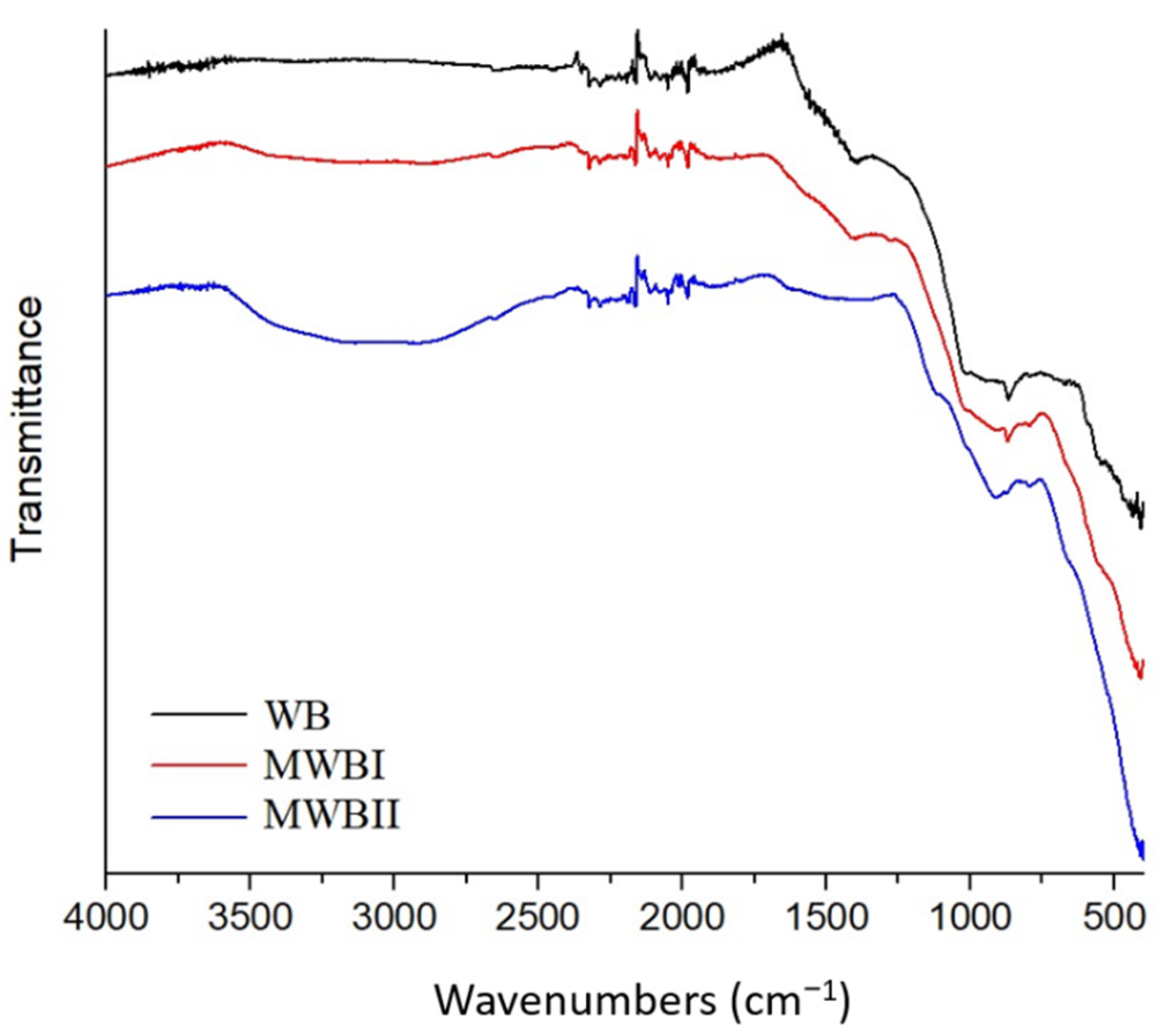
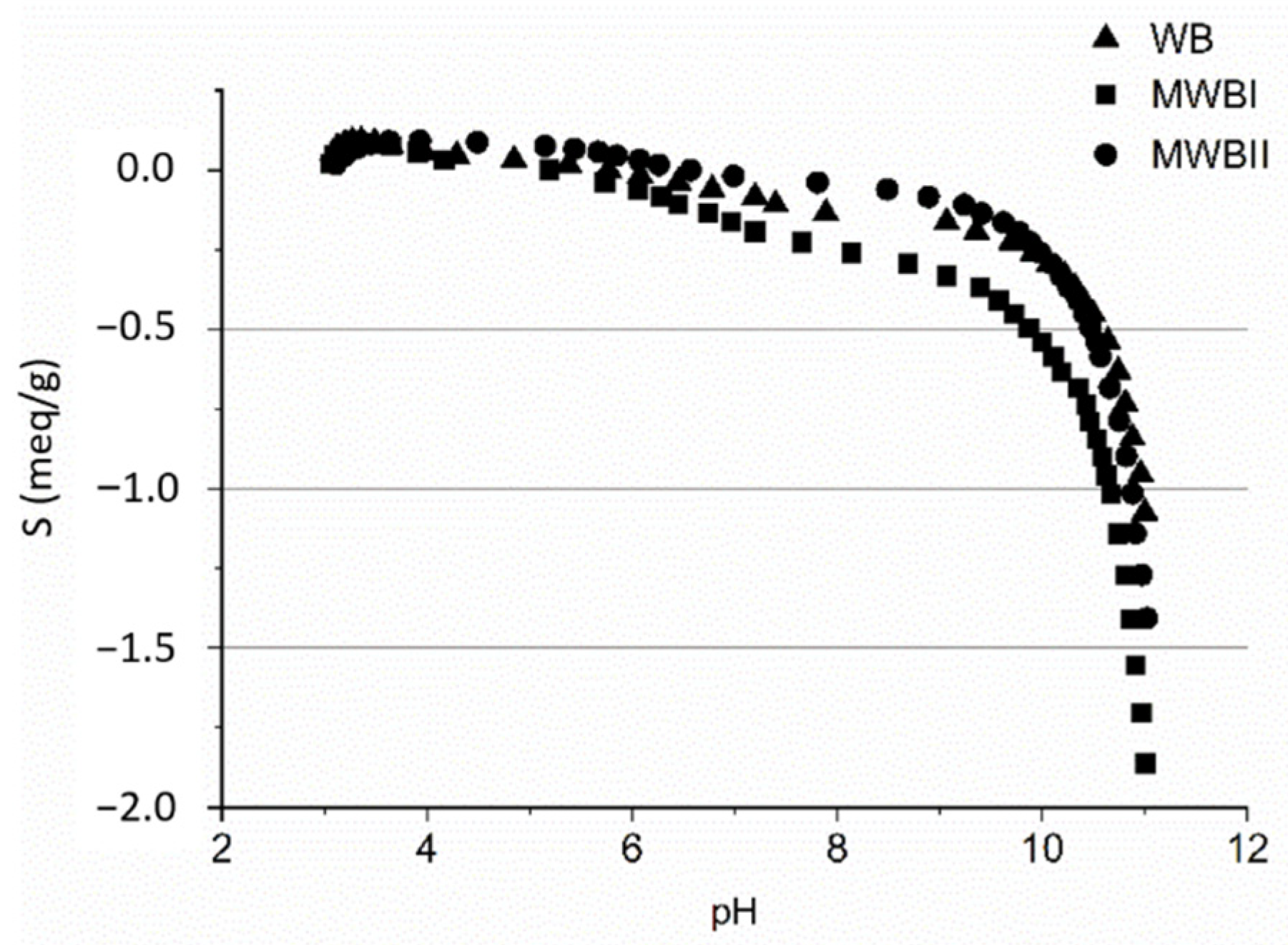
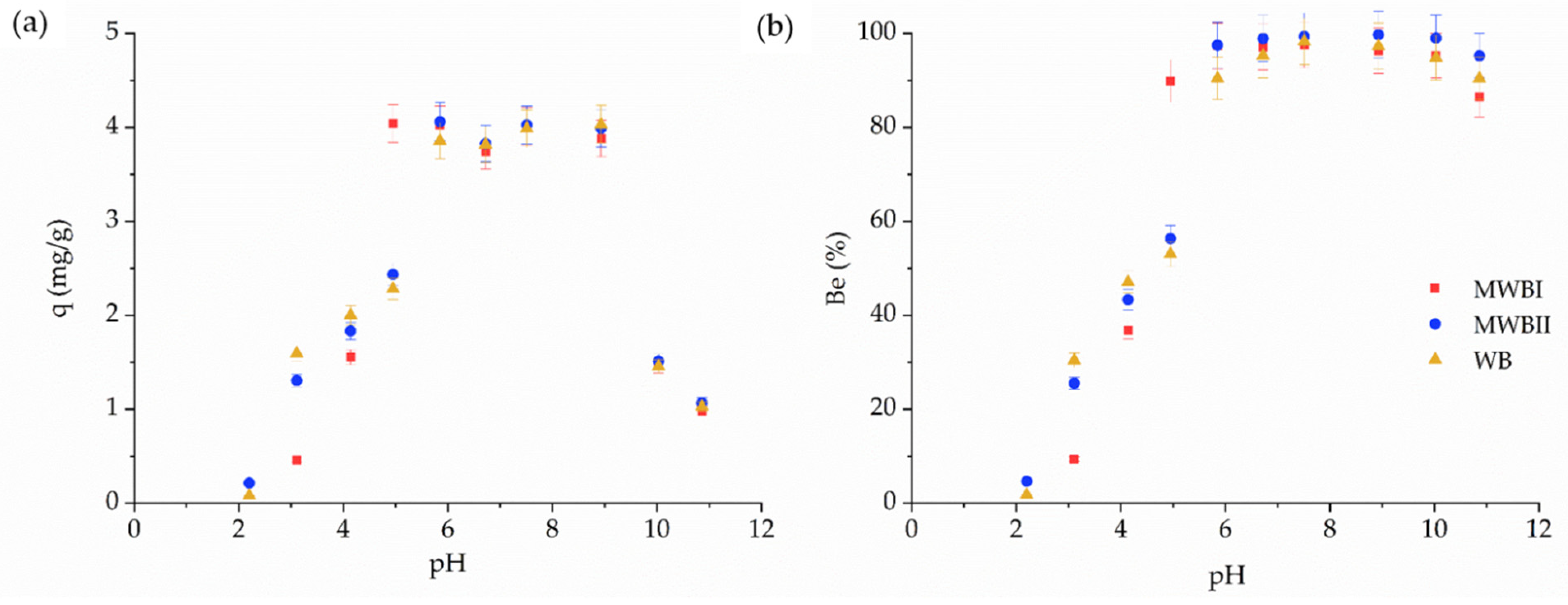
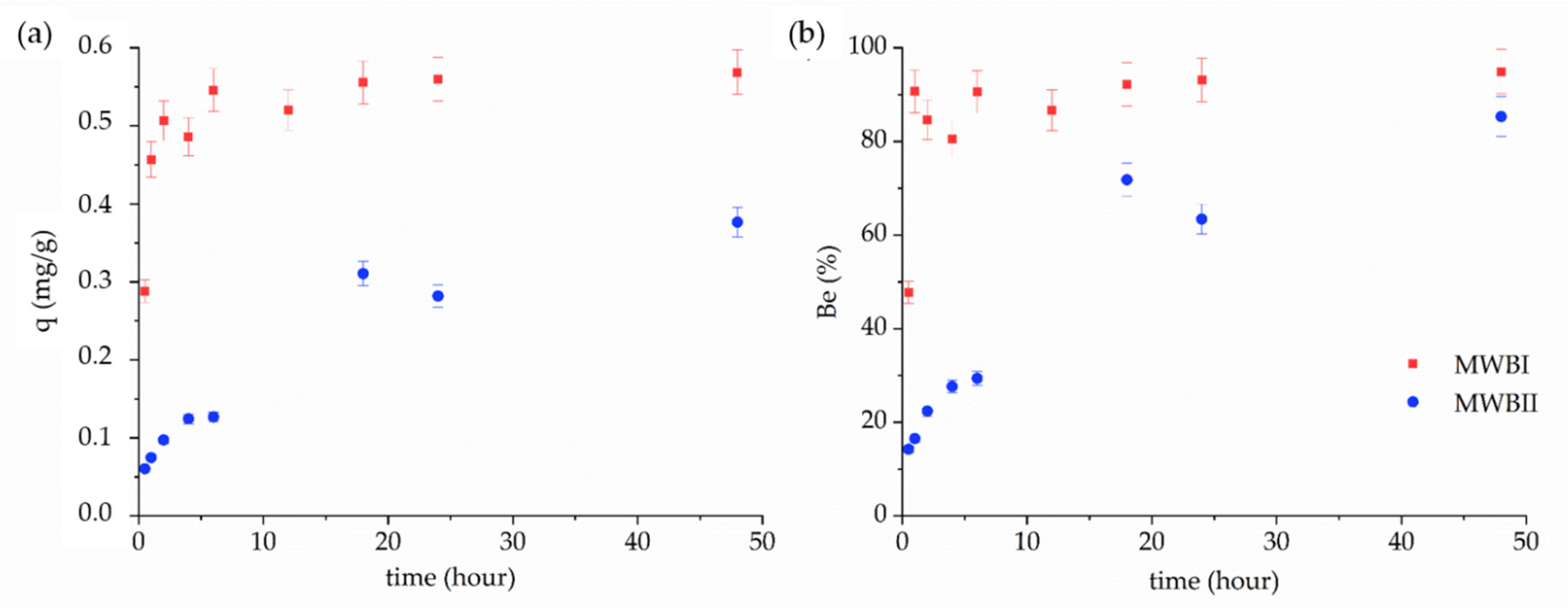



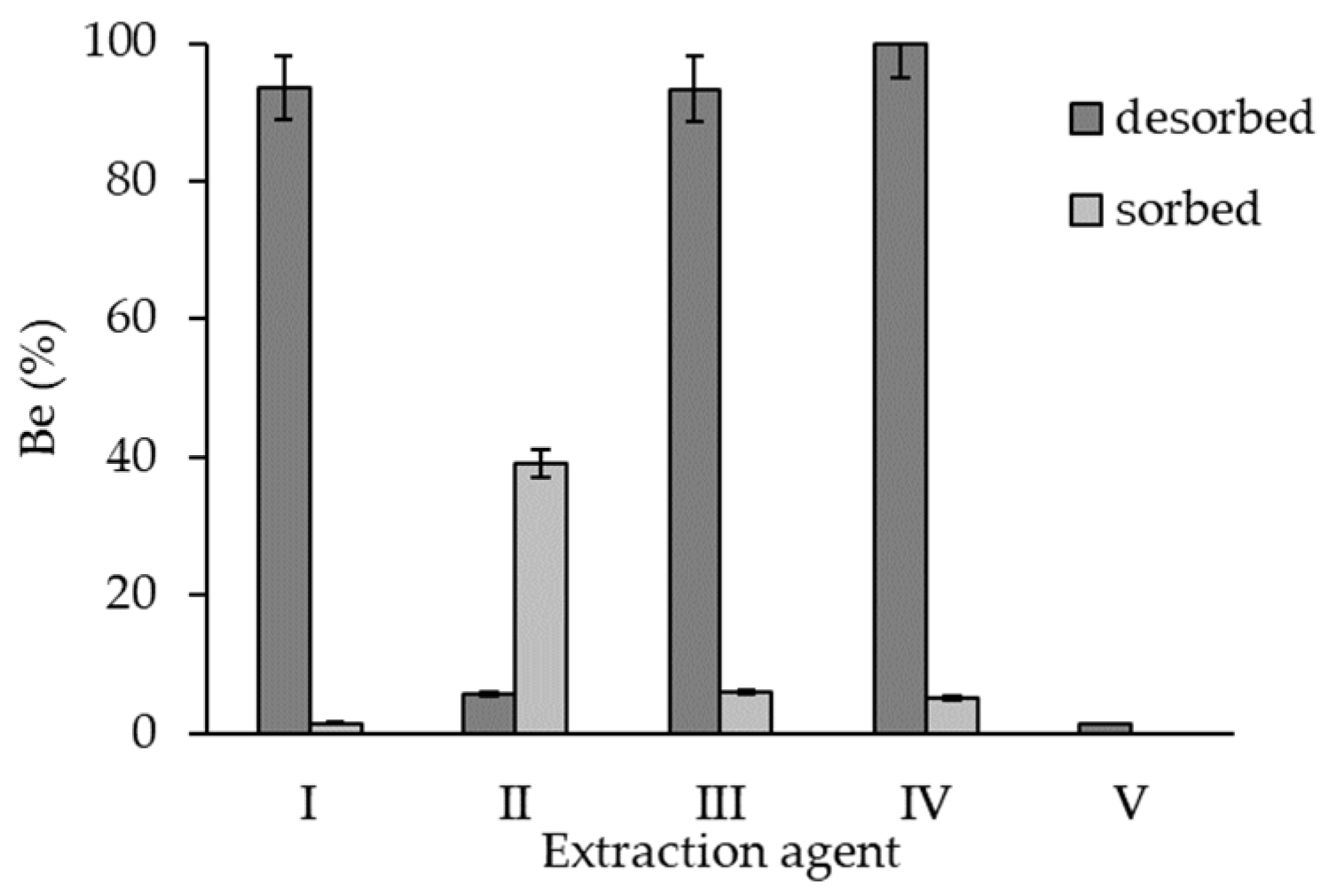
| Content | WB (wt.%) | MWBI (wt.%) | MWBII (wt.%) |
|---|---|---|---|
| Fe | 4.82 | 9.56 | 29.1 |
| SiO2 | 3.56 | 3.65 | 2.89 |
| K2O | 0.88 | 1.36 | 0.80 |
| CaO | 3.99 | 2.37 | 1.32 |
| Na2O | 0.77 | 0.64 | 0.59 |
| MgO | 0.56 | 0.58 | 0.26 |
| Al2O3 | 0.68 | 0.54 | 0.33 |
| P2O5 | 3.61 | 2.97 | 1.54 |
| SO3 | 0.59 | 1.04 | 0.76 |
| Cl | 0.003 | 0.04 | 0.03 |
| TiO2 | 0.15 | 0.07 | 0.05 |
| Cr2O3 | 0.10 | 0.06 | 0.04 |
| MnO | 0.10 | 0.07 | 0.08 |
| ZnO | 0.81 | 0.49 | 0.40 |
| LOI | 79.84 | 74.57 | 57.58 |
| Chemical Composition | WB | MWBI | MWBII |
|---|---|---|---|
| O | 70.05 | 74.63 | 68.44 |
| Al | 3.23 | 2.32 | 0.55 |
| Si | 6.96 | 5.18 | 0.86 |
| S | 1.94 | 1.73 | 0.38 |
| K | 0.43 | 0.88 | 0.54 |
| Ca | 8.03 | 3.97 | 0.44 |
| Fe | 9.37 | 11.30 | 28.80 |
| Total | 100.00 | 100.00 | 100.00 |
| Kinetic Model | Model Parameters | MWBI | MWBII |
|---|---|---|---|
| Pseudo-first-order | qteor (mg/g) | 0.122 | 0.482 |
| qe (mg/g) | 0.569 | 0.377 | |
| k1 (1/min) | 0.002 | 0.0005 | |
| R2 | 0.761 | 0.917 | |
| Pseudo-second-order | qteor (mg/g) | 0.573 | 0.418 |
| k2 (g/(mg.min)) | 0.057 | 0.130 | |
| R2 | 0.9996 | 0.953 | |
| Weber Morris model | Ki (mg/(g.min0.5)) | 0.0022 | 0.0069 |
| C (mg/g) | 0.4698 | 0.034 | |
| R2 | 0.709 | 0.959 | |
| IPD model | Ri | 0.174 | 0.912 |
| Strongly initial sorption | Weakly initial sorption |
| Kinetic Model | Isotherm Parameters | MWBI | MWBII |
|---|---|---|---|
| Freundlich | KF (mg/g) | 2.57 | 30.8 |
| n | 1.74 | 1.15 | |
| R2 | 0.226 | 0.625 | |
| Langmuir | qm (mg/g) | 0.944 | 4.31 |
| KL (L/mg) | 21.4 | 15.6 | |
| R2 | 0.250 | 0.628 | |
| RL | 0.024 | 0.032 | |
| Redlich-Peterson | A | 74.2 | 266 |
| B | 26.1 | 7.89 | |
| g | 0.43 | 0.166 | |
| R2 | 0.227 | 0.626 | |
| Sips | qm (mg/g) | 0.892 | 1.47 |
| KS (L/g) | 4372 | 4348 | |
| n (L/mg) | 0.009 | 0.03 | |
| R2 | 0.305 | 0.667 |
| Sorbent | Sorbent Dose | pH | Time (Min) | Active Sites | qexp (mg/g) | Ref. |
|---|---|---|---|---|---|---|
| Sulfated cross-linked chitosan | 20 mg/50 mL | 4 | 100 | Hydroxyl, sulfonic, amino | 40.6 | [14] |
| Polystyrene-azo-3,4-dihydroxybenzene | 10 mg/20 mL | 3.2–6.1 | 30 | Hydroxyl | 22.5 | [15] |
| Mesoporous silica 5-nitro-2-furaldehyde synthesized | 10 mg/10 mL | 7.2 | 30 | - | 0.034 | [78] |
| Aerobic granule | 3 g/1 L | 6 | 300 | Carboxyl, hydroxyl | 14 | [68] |
| Polystyrene Based Chelating Polymer | 10 mg/20 mL | 2.1–6.1 | 30–90 | - | 3.7–22.5 | [15] |
| Amberlite IR-120 | 0.8 g/100 mL | 3.5 | 120 | - | 11.7–38.7 | [16] |
| Magnetically modified biochar | 0.1 g/50 mL | 6 | 360 | Hydroxyl, carboxyl | 1.452 | Present study |
Publisher’s Note: MDPI stays neutral with regard to jurisdictional claims in published maps and institutional affiliations. |
© 2021 by the authors. Licensee MDPI, Basel, Switzerland. This article is an open access article distributed under the terms and conditions of the Creative Commons Attribution (CC BY) license (https://creativecommons.org/licenses/by/4.0/).
Share and Cite
Tokarčíková, M.; Motyka, O.; Peikertová, P.; Gabor, R.; Seidlerová, J. Magnetically Modified Biosorbent for Rapid Beryllium Elimination from the Aqueous Environment. Materials 2021, 14, 6610. https://doi.org/10.3390/ma14216610
Tokarčíková M, Motyka O, Peikertová P, Gabor R, Seidlerová J. Magnetically Modified Biosorbent for Rapid Beryllium Elimination from the Aqueous Environment. Materials. 2021; 14(21):6610. https://doi.org/10.3390/ma14216610
Chicago/Turabian StyleTokarčíková, Michaela, Oldřich Motyka, Pavlína Peikertová, Roman Gabor, and Jana Seidlerová. 2021. "Magnetically Modified Biosorbent for Rapid Beryllium Elimination from the Aqueous Environment" Materials 14, no. 21: 6610. https://doi.org/10.3390/ma14216610
APA StyleTokarčíková, M., Motyka, O., Peikertová, P., Gabor, R., & Seidlerová, J. (2021). Magnetically Modified Biosorbent for Rapid Beryllium Elimination from the Aqueous Environment. Materials, 14(21), 6610. https://doi.org/10.3390/ma14216610






